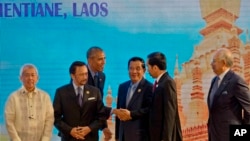As Barack Obama prepared to board Air Force One and leave the Laotian capital of Vientiane last September, he turned to salute.
The gesture may mark not only Obama’s departure from Laos, where he was attending the Asean summit, but also a wider departure of the Untied States from its strategic focus on Asia to compete with China.
The election of U.S. President Donald Trump has marked a significant shift in world affairs, analysts say.
Chheang Vannarith, chairman of the Cambodian Institute for Strategic Studies, said small- and medium-sized countries could now leverage themselves to assume regional or even global leadership positions amid a transition to a “multi-polar system”.
“This creates room for many countries in our region and elsewhere to formulate their own security regime – or regional architecture – to serve both regional and domestic interests in those countries,” Chheang said.
“In the long term, China will come to replace [the U.S.] in this region, so if the medium powers unite in an alliance system, they can resist the Chinese domination in the region, compensating the fading roles and presence of the U.S. in the region,” he added.
Nearly six months since Obama’s appearance at the summit in Vientiane, the new administration’s commitment to Obama’s regional strategy remains unclear.
Expectations that Trump will attend the East Asian summit in the Philippines in November are low and he had yet to mention Southeast Asia in a speech.
But analysts said the U.S. is unlikely to abandon the “Pivot to Asia” strategy just yet.
In February, the U.S. Navy sent its Carrier Strike Group on “routine” patrols of the South China Sea, close to where China had earlier that month installed missile launchers in contested waters.
"We have operated here in the past, we're going to operate here in the future, we're going to continue to reassure our allies," U.S. navy rear admiral James Kilby told the Associated Press last week.
The standoff between Asean members and China could hamper Asean from fulfilling its economic and political potential, Elina Noor, head of security studies at the Malaysian Institute for Strategic and International Studies, told VOA Khmer.
The South China Sea dispute has provoked controversy between Asean members, some of whom are at odds with China, while others have lent tacit support to the superpower.
“I think differences in interests and priorities [among the member states] affect Asean unity and centrality,” Noor said. “So if Asean is serious about its vision for 2025 and beyond, then it needs to make some very serious and mature positions about its current decision-making process as well as its structures and how it operates.”
To avoid derailing the project, Vannarith says the body needs to prevent its members from splitting along factional lines.
“Otherwise the region will fall freely into instability,” he said.
The need for leadership
Asean has hosted numerous global events chaired by its members over the past 20 years, but analysts see few long-lasting initiatives coming from the bloc.
“There needs to be a single driver of leadership and an agreement on agendas fostered for Asean as a collective institution,” said Noor.
However, the time may not be right to seek a single leader among Asean members while they appear to be “preoccupied” with domestic politics.
The election of Philippines President Rodrigo Duterte, the growing power of the Thai junta, the 1MDB scandal enveloping Malaysia’s Prime Minister Najib Razak, a pre-election crackdown on dissent in Cambodia and the deepening crisis in Myanmar has rocked the region.
A larger leadership role for Asean could be tested following the recent killing of the half-brother of North Korean dictator Kim Jong Nam, who was killed in Malaysia last month.
“Southeast Asia, which has traditionally been not so associated with the troubles in Northeast Asia, will begin to be drawn into the … politics of the Korean Peninsula,” Noor said.







